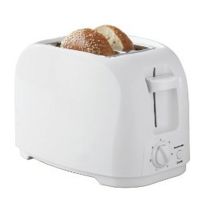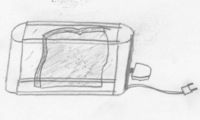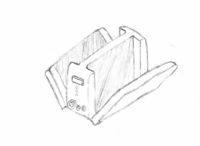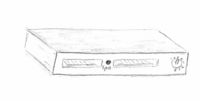Wikipedia:Sandbox
From DDL Wiki
(→FMEA) |
Current revision (11:50, 1 December 2008) (view source) |
||
| (12 intermediate revisions not shown.) | |||
| Line 1: | Line 1: | ||
| - | = | + | =Failure Mode and Effects Analysis= |
Failure Mode and Effects Analysis (FMEA) is a crucial tool in determining if a particular component in a system will fail (in terms of the customer's requirements). By looking at each piece, we can rate the severity of a failure (S), the probability that it will occur (P), and the likelihood that the customer would detect the failure (D). The severity of failure is rated between 1-10, 1 being the effect is not noticed by the consumer, while 10 is hazardous. Probability of occurence is also rated from 1-10, 1 being extremely remote while 10 has an extremely high chance of occurring. Finally, detection is rated from 1-10 with 1 being almost certain to detect and 10 being no chance of detection whatsoever. With these three factors, we can multiply them together to achieve a total risk priority number (RPN) which can range from 1-1000 (1000 being the greatest risk). Below is a table outlining each part. | Failure Mode and Effects Analysis (FMEA) is a crucial tool in determining if a particular component in a system will fail (in terms of the customer's requirements). By looking at each piece, we can rate the severity of a failure (S), the probability that it will occur (P), and the likelihood that the customer would detect the failure (D). The severity of failure is rated between 1-10, 1 being the effect is not noticed by the consumer, while 10 is hazardous. Probability of occurence is also rated from 1-10, 1 being extremely remote while 10 has an extremely high chance of occurring. Finally, detection is rated from 1-10 with 1 being almost certain to detect and 10 being no chance of detection whatsoever. With these three factors, we can multiply them together to achieve a total risk priority number (RPN) which can range from 1-1000 (1000 being the greatest risk). Below is a table outlining each part. | ||
| + | =Fender Bridge FMEA= | ||
{| class="wikitable" border="1" | {| class="wikitable" border="1" | ||
|- | |- | ||
| - | ! Part & Function !! Failure Mode !! Effect of failure !! Causes of failure !! Detection !! S !! O !! D !! RPN !! Action !! S !! O !! D | + | ! Part & Function !! Failure Mode !! Effect of failure !! Causes of failure !! Detection !! S !! O !! D !! RPN !! Action !! S !! O !! D !!RPN |
| - | |- | + | |
| - | + | |- valign="top" | |
| - | | | + | | rowspan="1" | (G1) Back Panel/ Pickguard Screws |
| - | |- | + | *Fastener for back panel |
| - | ! | + | | Stripped Screw || |
| - | | | + | Lodged Screw |
| - | |} | + | | *Wrong Screwdriver <br />*Over tightening of screw || Stuck Screw|| 3 || 3 || 2 || 18 || |
| + | Advise user of possibility of stripped screws | ||
| + | || 3 || 2 || 2 || 12 | ||
| + | |||
| + | |- valign="top" | ||
| + | | rowspan="1" | (G2) Back Panel | ||
| + | *Protects Rear Bridge Mount and Springs | ||
| + | | Brittle Fracture || | ||
| + | Exposed Springs and rear bridge | ||
| + | | *Dropping on a hard surface and/or a great height || Broken Plastic Pieces|| 4 || 5 || 1 || 20 || | ||
| + | Replace plastic material with something more robust like steel or aluminum | ||
| + | || 4 || 3 || 1 || 12 | ||
| + | |- | ||
| + | ! (G3) Strings | ||
| + | |- | ||
| + | ! (G4) Springs | ||
| + | |- | ||
| + | ! (G5) Whammy Bar | ||
| + | |- | ||
| + | ! (G6) Bridge Mounting Screws | ||
| + | |- | ||
| + | ! (G7) Bridge Assembly | ||
| + | |- | ||
| + | ! (G8) Spring Claw | ||
| + | |- | ||
| + | ! (G9) Spring Claw Screws | ||
| + | |- | ||
| + | ! (G10) Saddle Plate | ||
| + | |- | ||
| + | ! (G11) Saddle Spring} | ||
| + | |- | ||
| + | ! (G12) Saddle Screw | ||
| + | |- | ||
| + | ! (G13) Neck | ||
| + | |- | ||
| + | ! (G14) Neck Mounting Plate | ||
| + | |- | ||
| + | ! (G15) Bridge Block | ||
| + | |- | ||
| + | ! (G16) Bridge Block Mounting Screws | ||
| + | |- | ||
| + | ! (G17) Guitar Body | ||
| + | |- | ||
| + | ! (G18) Bridge Plate | ||
| + | |- | ||
| + | } | ||
| + | |||
| + | |||
| + | |||
| + | |||
| + | |||
| + | {| class="wikitable" border="1" cellspacing="0" align="center" | ||
| + | |- align="center" | ||
| + | ! colspan="2" | Description | ||
| + | | '''Standard Toaster''' || '''Clear Wall Toaster''' || '''Fold Out Toaster''' || '''Enclosed Toaster''' || '''Front Load Toaster''' | ||
| + | |- align="center" | ||
| + | ! colspan="2" | Sketch || [[Image:toaster.jpg|200px]] || [[Image:Toaster-ClearWall-Overall.jpg|200px]] || [[Image:toaster-FoldOut-Open.jpg|200px]] || [[Image:Toaster-Enclosed-Front.jpg|200px]] || [[Image:Toaster-FrontLoad-Overall.jpg|200px]] | ||
| + | |- align="center" | ||
| + | | style="border-bottom:3px solid grey;" | '''Criteria''' || style="border-bottom:3px solid grey;" |'''Weight''' || style="border-bottom:3px solid grey;" | '''Datum 1''' || style="border-bottom:3px solid grey;" | '''Design 1''' || style="border-bottom:3px solid grey;" | '''Design 2''' || style="border-bottom:3px solid grey;" | '''Design 3''' || style="border-bottom:3px solid grey;" | '''Design 4''' | ||
| + | |- | ||
| + | |||
| + | } | ||
Current revision
Failure Mode and Effects Analysis
Failure Mode and Effects Analysis (FMEA) is a crucial tool in determining if a particular component in a system will fail (in terms of the customer's requirements). By looking at each piece, we can rate the severity of a failure (S), the probability that it will occur (P), and the likelihood that the customer would detect the failure (D). The severity of failure is rated between 1-10, 1 being the effect is not noticed by the consumer, while 10 is hazardous. Probability of occurence is also rated from 1-10, 1 being extremely remote while 10 has an extremely high chance of occurring. Finally, detection is rated from 1-10 with 1 being almost certain to detect and 10 being no chance of detection whatsoever. With these three factors, we can multiply them together to achieve a total risk priority number (RPN) which can range from 1-1000 (1000 being the greatest risk). Below is a table outlining each part.





